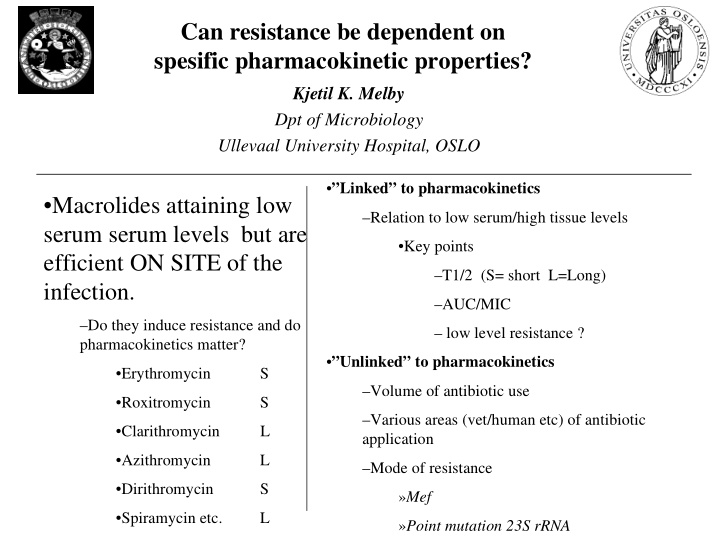



Can resistance be dependent on spesific pharmacokinetic properties? Kjetil K. Melby Dpt of Microbiology Ullevaal University Hospital, OSLO • ”Linked” to pharmacokinetics •Macrolides attaining low –Relation to low serum/high tissue levels serum serum levels but are •Key points efficient ON SITE of the –T1/2 (S= short L=Long) infection. –AUC/MIC –Do they induce resistance and do – low level resistance ? pharmacokinetics matter? • ”Unlinked” to pharmacokinetics •Erythromycin S –Volume of antibiotic use •Roxitromycin S –Various areas (vet/human etc) of antibiotic •Clarithromycin L application •Azithromycin L –Mode of resistance •Dirithromycin S » Mef •Spiramycin etc. L » Point mutation 23S rRNA
Areas of resistance developement Drug Serum level Saliva levels(fraction) Tissue ”PDAC” # Site of infection vrs Ery 3 0,1-1.0 x3(?) short NORMAL FLORA Clar 2 0,1 -1.0 x3(?) short Azithro 1 0,1 -1,0 x10 (?) long # Post Dosage Antibiotic Challenge (Drug elimination) Macrolide Residing MMM Residing flora M flora? Potential pathogens Infecting Developement of organism resistance?? TARGET (M) nov 01 KKM 2
Macrolide resistance developement Relation to type of macrolide Comments: •Low level exposure to antibiotic implies: Induction of low level resistance. •Related to type of antibiotic Conclusion : •Beta-lactams Increase in •Macrolides Erythromycin • Consequences resistance •Global: Gradual Increase in increase in bacterial azithromycin resistance. use •Practical •Revision of indication(s) ? Approaches In vitro studies: Nagai et al: JAC 2000 46: 909-915 Adapted from Baquero, J. Chemother 11: 35-43, 1999 In vivo results: nov 01 KKM 3
Resistance developement Relation to macrolide use Data from Norway Conclusion: NO increase in resistance in Norway but low increase in azithromycin usage nov 01 KKM 4
Final comments - macrolides Q: Can resistance be dependent on specific pharmacokinetic properties? A: Probably – Yes; if their different actions on local (normal) flora are considered a consequence of pharmacokinetics of the compound (”PDAC”). INFEC TED Thus to consider: Longacting macrolides (Azithromycin) should • AREA be used in infections due to obligatory pathogens (not potential partner(s) of the local ”normal flora”) • Regulatory board should ask for data on low level resistance development for new compounds nov 01 KKM 5
Pharmacokinetic prophiles - macrolides Note: MICs and serum levels differences Az vrs Er • Erytromycin (Er) • Clarithromycin •Roxitromycin • Azitromycin(Az) •Spiramycin •Dirythromycin •Other 2 1,8 1,6 1,4 1,2 1 0,8 0,6 0,4 0,2 0 1 2 3 4 5 6 7 nov 01 KKM 6
Recommend
More recommend